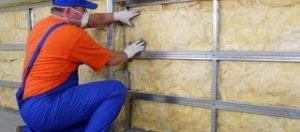Insulation is Important Year-Round

The most powerful and energy-efficient HVAC system available will be nearly useless if your commercial building isn’t properly insulated. Here is a brief introduction to insulation and its purpose and why you need to make sure your commercial space has plenty of the right insulation.
Insulation Basics
The basic function of insulation is to limit the movement of heat. The principles of physics show that heat always moves from a place of greater heat to a place of lesser heat. Insulation slows and restricts this movement of heat and, by doing so, helps keep your indoor spaces cooler in the summer and warmer in the winter.
For example, in the summer, outdoor heat will naturally move toward cooler indoor areas. This raises the temperature inside your building and makes the space uncomfortable. Cool air produced by your air conditioner or heat pump will be insufficient as the incoming heat from outside overwhelms the HVAC system’s ability to maintain lower indoor temperatures. With the proper type and amount of insulation, however, less heat will be able to enter and your indoor spaces will stay cooler.
In the winter, an opposite effect occurs. The heat produced by your furnace, boiler, or heat pump will move away from your indoor spaces and to the colder areas outside. Insulation restricts this natural flow of heat and keeps your indoor spaces warmer.
Without insulation, normal HVAC systems will be unable to keep up with the daily demands for heating or cooling. The additional heat in the summer, or the loss of heat in the winter, will eliminate any benefit you receive from a high-efficiency HVAC system.
- You’ll waste significant amounts of energy with little return.
- Your heating or cooling system will work harder to keep up, putting additional wear and tear on the equipment.
- You’ll waste money by spending more than necessary to heat or cool your indoor spaces. R-Values Insulation effectiveness is measured by its R-Value, or coefficient of heat transfer resistance.
R-Values
indicate how effectively insulation slows and resists the flow of heat, either inward during the summer or outward during the winter. Higher R-Values mean that the insulation is better at resisting heat flow.
Different types of insulation material will have different R-Values. R-Values will also vary based on the thickness and density of the insulation material. Compressed insulation will also have a different R-Value than non-compressed material. Each layer of insulation is accounted for separately, and the R-Value of each layer adds up to the total R-Value of a particular piece of insulation.
In Pennsylvania, New Jersey, Delaware, and Maryland, the U.S. Department of Energy recommends:
- R-Value R-38 to R-60 for attics
- R-Value R-13 to R-15 for wall cavities
- R-Value R-25 to R-30 for floors
Common Insulation Materials
- Batt or blanket insulation: This insulation consists of layers of fiberglass sandwiched between sheets of heavy paper or cardboard, creating a “blanket” of insulation. Blanket insulation is often installed between wall beams and joists and between beams in ceilings and floors.
- Loose-fill insulation: Loose-fill insulation consists of pellets of cellulose or fiberglass sprayed into wall cavities or large open areas. This type of insulation is often used in areas with irregular shapes that would be hard to reach with blanket-style insulation.
- Spray foam: This type of insulation is applied as a foam that can be shaped if needed. It dries to create a lightweight layer of dense insulation that can stop air leaks while also providing substantial heat resistance.
- Rigid board: Rigid fiberglass board insulation is commonly used to insulate HVAC ductwork. This prevents heat loss or gain through the material of the ducts themselves.
Our goal is to help educate our customers about Plumbing, HVACR, Fire Protection, and Alarm Systems in Mechanical, Commercial, and Residential settings. For more information on insulation and how it affects HVAC system efficiency and indoor comfort year-round, or to view projects we’ve worked on, visit our website!
Photo Credit: heatsavers via Compfight cc







